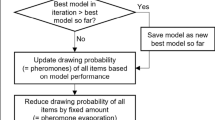Abstract
A Likert scale is a psychometric response scale primarily used in questionnaires to obtain participants’ preferences or degree of agreement with a statement or set of statements. Respondents are asked to indicate their level of agreement with a given statement using an ordinal scale. Nowadays, Companies often use Likert surveys to discern the capabilities and skills of current or potential employees, asking multiple questions about each competency. With such a questionnaire, different competencies are evaluated and therefore, the result of a questionnaire will provide important information about capabilities and skills of the respondents. As an example, we will describe, for a real questionnaire, how to classify each question with the corresponding competency. That is, to find, for each Likert item, which competency is evaluated. We will present how to face and solve the problem using two different techniques: an approximate method, using a genetic algorithm and an exact algebraic method, solving a quadratic system of n equations and n unknowns. Finally, we will set the basics to solve this competency-assignment problem for a generalized version of similar questionnaires with n Likert items for evaluating m competencies. The advantages and disadvantages of both techniques will be also shown.
Similar content being viewed by others
References
Aguilera, G., Galán, J.L., Galán, M.A., Padilla, Y., Rodríguez, P.: Generating random samples from continues and discrete distributions with Derive. Deriv. Newslett. 75, 22–43 (2009)
Aguilera, G., Galán, J.L., Galán, M.A., Rodríguez, P.: Teaching semantic tableaux method for propositional classical logic with a cas. Int. J.Technol. Math. Educ. 22(2), 85–91 (2015)
Aguilera, G., Galán, J.L., García, J.M., Mérida, E., Rodríguez, P.: An accelerated-time simulation of car traffic on a motorway using a cas. J. Math. Comput. Simula. 104, 21–30 (2014). doi:10.1016/j.matcom.2012.03.010
Aguilera, G., Galán, J.L., Madrid, R., Martínez, A.M., Padilla, Y., Rodríguez, P.: Automated generation of contrapuntal musical compositions using probabilistic logic in Derive. J. Math. Comput. Simula. 80(6), 1200–1211 (2010). doi:10.1016/j.matcom.2009.04.012
Allen, I.E., A., S.C.: Likert scales and data analyses, quality progress (2007) http://mail.asq.org/quality-progress/2007/07/statistics/likert-scales-and-data-analyses.html
Clason, D.L., Dormody, T.J.: Analyzing data measured by individual likert-type items. J. Agric. Educ. 35(4), 31–35 (1994). doi:10.5032/jae.1994.04031
Dawes, J.: Do data characteristics change according to the number of scale points used? An experiment using 5-point, 7-point and 10-point scales. Int. J. Market Res. 50(1), 61–77 (2008)
Deep, K., Singh, K.P., Kansal, M., Mohan, C.: A real coded genetic algorithm for solving integer and mixed integer optimization problems. Appl. Math. Comput. 212(2), 505–518 (2009). doi:10.1016/j.amc.2009.02.044
Finstad, K.: Response interpolation and scale sensitivity: evidence against 5-point scales. J. Usability Stud. 5(3), 104–110 (2010)
Galán, J.L., Rodríguez, P., Galán, M.A., Padilla, Y.: Multiple integration.dfw and complex analysis.dfw, user contributed math packages of software Derive 6. texas instruments (2004)
Galán-García, J.L., Aguilera-Venegas, G., Galán-García, M.A., Rodríguez-Cielos, P., Atencia-Mc.Killop, I.: Improving CAS capabilities: New rules for computing improper integrals. Appl. Math. Comput. In Press (Corrected Proof) (2016) doi:10.1016/j.amc.2016.12.024
Garland, R.: The mid-point on a rating scale: Is it desirable? Mark. Bull. 2(3), 66–70 (1991)
Göb, R., McCollin, C., Ramalhoto, M.F.: Ordinal methodology in the analysis of likert scales. J. Qual. Quant. 41(5), 601–626 (2007). doi:10.1007/s11135-007-9089-z
Irshada, M., Khalidb, S., Hussainb, M.Z., Sarfraz, M.: Outline capturing using rational functions with the help of genetic algorithm. Appl. Math. Comput. 274, 661–678 (2016). doi:10.1016/j.amc.2015.10.014
Likert, R.: A technique for the measurement of attitudes. Arch. Psychol. 140, 1–55 (1932)
McCall, J.: Genetic algorithms for modelling and optimisation. J. Comput. Appl. Math. 184, 205–222 (2005). doi:10.1016/j.cam.2004.07.034
Pakdaman, M., Ahmadian, A., Effati, S., Salahshour, S., Baleanu, D.: Solving differential equations of fractional order using an optimization technique based on training artificial neural network. Appl. Math. Comput. 293(2), 81–95 (2017). doi:10.1016/j.amc.2016.07.021
Wikipedia. Genetic algorithm, wikipedia, the free encyclopedia (2016a) http://en.wikipedia.org/wiki/Genetic_algorithm
Wikipedia. Likert scale, wikipedia, the free encyclopedia (2016b) http://en.wikipedia.org/wiki/Likert_scale
Yu, Y., Xu, D.: On the inverse problem of thermal conductivity determination in nonlinear heat and moisture transfer model within textiles. Appl. Math. Comput. 264, 284–299 (2015). doi:10.1016/j.amc.2015.04.084
Author information
Authors and Affiliations
Corresponding author
Rights and permissions
About this article
Cite this article
Galán-García, J.L., Merino, S., Martínez, J. et al. Genetic and Algebraic Algorithms for Classifying the Items of a Likert Questionnaire. Math.Comput.Sci. 11, 49–59 (2017). https://doi.org/10.1007/s11786-017-0289-1
Received:
Revised:
Accepted:
Published:
Issue Date:
DOI: https://doi.org/10.1007/s11786-017-0289-1




